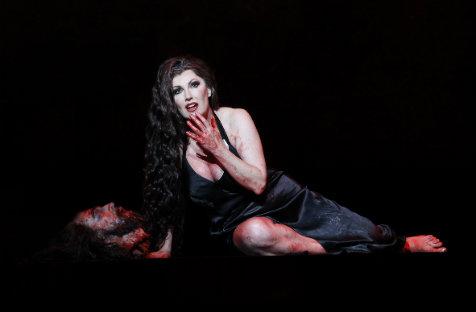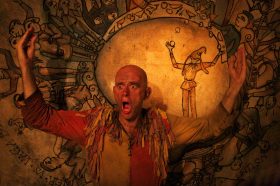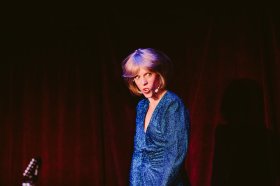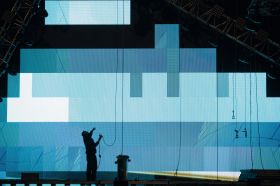Opera Australia seems to be in tune with the times. This current Melbourne season comprises three operas featuring young females who are victims of the constraints of misogynistic, male dominated societies. All three die because of the men around them; however, unlike the pity and tears engendered by the tragic ends of Cio Cio San in Madama Butterfly and Lucia in Lucia di Lammermoor, Salome’s fate inspires shock and revulsion as we view her as both victim and perpetrator. When Butterfly suicides by slitting her throat in Opera Australia’s production, there is a total absence of blood, but it is featured in the staging of the Donizetti and Strauss operas. The latter comes as a culmination of gory horror, with blood infusing Salome’s madness and the perversion of Herod’s court.
The success of all three operas relies heavily on the acting and vocal ability of the eponymous divas. Strauss is quoted as describing Salome as a ‘sixteen year old Princess with the voice of Isolde’. This begs the question of whether it is possible for a mature singer with vocal heft to play the role of a sixteen year old girl convincingly. Given that Salome’s sensuality and powers of seduction are the focus of the opera, it would be hard to find anybody more capable of conveying these qualities than Cheryl Barker. As well as being blessed with physical beauty, her total immersion in the role was chillingly convincing, particularly in the final scene as she possesses the bloody severed head of Jokanaan. Although her voice was occasionally overwhelmed in the lower reaches when pitted against some orchestral climaxes, her upper register was always powerfully projected. This addition to her roles as Strauss’s Marschallin, Countess and Arabella further establishes Barker’s credentials as a Strauss singer of note.
Some members of the audience may have been disappointed that Barker did not perform the entire ‘Dance of the Seven Veils’ herself; after all, that is possibly the most celebrated feature of the story. Instead, Gale Edwards has used a succession of dances reflecting seven clichés of male sexual fantasy. As with other aspects of her direction in this opera, contemporary elements have been introduced. Opera Australia has a video link on their website so that you can preview snippets of the dances, but I would strongly advise against this as they fall far short of doing justice to the live version of Kelley Abbey’s choreography. A surprise element also adds to the experience.
Another aspect of the direction that may prove controversial is the addition of the modern religious representatives brought to the banquet by Herod to debate the legitimacy of John the Baptist as a prophet. The absence of the moon (apart from Salome’s head gear), so central to the imagery in the text, and light emanating from the Baptist’s cell, despite references to how dark it must be for him, are further possible points of contention. It is puzzling as to why strong muscle definition, including a dirty looking six-pack, is shaded on his body when Salome makes a point of his ivory skin.
Nevertheless, a range of details, such as the Last Supper tableau at the beginning of the opera when a boar’s head is brought in on a platter, add to the interest and unity of this production. The backdrop of carcasses, which emerge and recede during the course of the opera, may be an overly obvious way of underscoring the butchery, but they are very much in keeping with the overall design, mood, and action. The emphasis on butchery finds its climax in the final shocking slitting of Salome’s throat.
Apart from Cheryl Barker’s embodiment of Salome, the greatest strength of this production is the performance of the music. As Jokanaan, Thomas Hall is outstanding. He is first heard in heavily amplified form denouncing Herod and Herodias from his cell. The un-amplified version as he climbs from his cell could have been comparatively pale, but was in fact rich and resonant. David Corcoran (Narraboth), Sian Pendry (Page), Jacqueline Dark (Herodias) and John Pickering (Herod) were all excellent. The ensemble work was particularly fine as the religious leaders squabbled among themselves.
Orchestra Victoria was in great form under the baton of Simon Hewitt. Their assured playing of this remarkable score was carefully shaped and full of drive and passion. If the blood and gore gets too much for you, just close your eyes and revel in the sensuality of the glorious music.
Rating: 4 stars out of 5
Opera Australia presents
Salome
By Richard Strauss
Conductor: Simon Hewett
Director: Gale Edwards
Set Designer: Brian Thomson
Costume Designer: Julie Lynch
Lighting Designer: John Rayment
Choreographer: Kelley Abbey
Orchestra Victoria
Cast: John Pickering, Jacqueline Dark, Cheryl Barker, Thomas Hall, David Corcoran, Sian Pendry, Kanen Breen, Graeme Macfarlane, Benjamin Rasheed, Brad Cooper, Richard Anderson, Shane Lowrencev, Sitiveni Talei, Adrian Tamburini, Tom Hamilton and Andrew Moran
State Theatre, Arts Centre Melbourne
1 – 15 December





